翻译项目管理教材
- 格式:ppt
- 大小:5.33 MB
- 文档页数:50
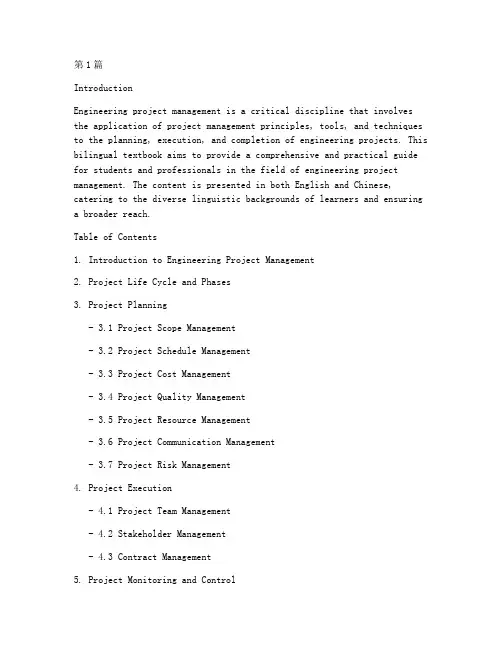
第1篇IntroductionEngineering project management is a critical discipline that involves the application of project management principles, tools, and techniques to the planning, execution, and completion of engineering projects. This bilingual textbook aims to provide a comprehensive and practical guide for students and professionals in the field of engineering project management. The content is presented in both English and Chinese, catering to the diverse linguistic backgrounds of learners and ensuring a broader reach.Table of Contents1. Introduction to Engineering Project Management2. Project Life Cycle and Phases3. Project Planning- 3.1 Project Scope Management- 3.2 Project Schedule Management- 3.3 Project Cost Management- 3.4 Project Quality Management- 3.5 Project Resource Management- 3.6 Project Communication Management- 3.7 Project Risk Management4. Project Execution- 4.1 Project Team Management- 4.2 Stakeholder Management- 4.3 Contract Management5. Project Monitoring and Control- 5.1 Project Performance Measurement- 5.2 Change Management- 5.3 Conflict Resolution6. Project Closure7. Case Studies8. BibliographyChapter 1: Introduction to Engineering Project Management1.1 Definition and ImportanceEngineering project management refers to the application of project management principles, tools, and techniques to the planning, execution, and completion of engineering projects. It is essential for the successful delivery of projects within the constraints of time, cost, and quality.1.2 Key Concepts- Project: A unique set of activities designed to produce a product, service, or result with a defined beginning and end.- Project Management: The application of knowledge, skills, tools, and techniques to project activities to meet project requirements.- Project Manager: The person responsible for leading the project, managing resources, and ensuring the successful completion of the project.1.3 Objectives of Engineering Project Management- Scope: Define and manage the project scope to ensure that the project meets the specified requirements.- Time: Control the project schedule to ensure that the project is completed on time.- Cost: Manage the project budget to ensure that the project is completed within the allocated budget.- Quality: Ensure that the project deliverables meet the specified quality standards.- Risk: Identify, analyze, and manage project risks to minimize their impact on the project.Chapter 2: Project Life Cycle and Phases2.1 Project Life CycleThe project life cycle consists of four phases: initiation, planning, execution, and closure.2.2 Initiation PhaseThe initiation phase is the first phase of the project life cycle. It involves defining the project objectives, identifying stakeholders, and obtaining approval to proceed.2.3 Planning PhaseThe planning phase involves defining the project scope, developing a project schedule, estimating costs, identifying resources, and developing a project management plan.2.4 Execution PhaseThe execution phase is where the project plan is implemented. This phase involves managing resources, monitoring progress, and controlling changes to the project scope.2.5 Closure PhaseThe closure phase is the final phase of the project life cycle. It involves completing all project activities, documenting lessons learned, and obtaining formal acceptance of the project deliverables.Chapter 3: Project PlanningThis chapter delves into the various aspects of project planning, including scope, schedule, cost, quality, resources, communication, and risk management.3.1 Project Scope ManagementProject scope management involves defining and controlling what is andis not included in the project. It includes activities such as scope planning, scope definition, scope verification, and scope control.3.2 Project Schedule ManagementProject schedule management involves developing a project schedule, managing the schedule, and controlling changes to the schedule. It includes activities such as schedule planning, schedule development, schedule control, and schedule change control.3.3 Project Cost ManagementProject cost management involves estimating, budgeting, financing, funding, managing, and controlling costs throughout the project life cycle. It includes activities such as cost estimation, cost budgeting, cost control, and cost variance analysis.3.4 Project Quality ManagementProject quality management involves planning, implementing, and controlling quality to meet project requirements. It includes activities such as quality planning, quality assurance, quality control, and continuous improvement.3.5 Project Resource ManagementProject resource management involves acquiring, developing, and managing the resources needed for the successful completion of the project. It includes activities such as resource planning, resource acquisition, resource management, and resource control.3.6 Project Communication ManagementProject communication management involves planning, executing, and controlling the project communications according to the communications management plan. It includes activities such as communication planning, information distribution, stakeholder management, and communication control.3.7 Project Risk ManagementProject risk management involves identifying, analyzing, and responding to project risks. It includes activities such as risk identification, risk analysis, risk response planning, and risk monitoring and control.Chapter 4: Project ExecutionThis chapter focuses on the execution phase of the project life cycle, covering topics such as project team management, stakeholder management, and contract management.4.1 Project Team ManagementProject team management involves forming, leading, and managing the project team to achieve project objectives. It includes activities such as team building, team leadership, and team performance management.4.2 Stakeholder ManagementStakeholder management involves identifying, analyzing, and managing stakeholders' needs and expectations throughout the project life cycle. It includes activities such as stakeholder identification, stakeholder analysis, stakeholder engagement, and stakeholder communication.4.3 Contract ManagementContract management involves managing the contractual relationships between the project organization and its stakeholders. It includes activities such as contract planning, contract administration, and contract closure.Chapter 5: Project Monitoring and ControlThis chapter discusses the monitoring and control phase of the project life cycle, focusing on project performance measurement, change management, and conflict resolution.5.1 Project Performance MeasurementProject performance measurement involves monitoring and controlling the project to ensure that it is progressing according to the project management plan. It includes activities such as performance reporting, variance analysis, and corrective actions.5.2 Change ManagementChange management involves managing changes to the project scope, schedule, cost, and quality. It includes activities such as change request management, change control, and configuration management.5.3 Conflict ResolutionConflict resolution involves identifying, analyzing, and resolving conflicts among project stakeholders. It includes activities such as conflict analysis, negotiation, and mediation.Chapter 6: Project ClosureThis chapter covers the closure phase of the project life cycle, focusing on completing all project activities, documenting lessons learned, and obtaining formal acceptance of the project deliverables.Chapter 7: Case StudiesThis chapter includes real-world case studies that illustrate the application of project management principles and techniques in various engineering projects.Chapter 8: BibliographyThis chapter provides a list of references for further reading on engineering project management.ConclusionThis bilingual textbook on engineering project management aims to provide a comprehensive and practical guide for students and professionals in the field. By covering the essential concepts, tools, and techniques of project management, this textbook will help readers develop the skills and knowledge necessary to successfully manage engineering projects.第2篇前言随着全球经济的快速发展和国际合作的日益加深,工程项目管理作为一门综合性的学科,其重要性不言而喻。
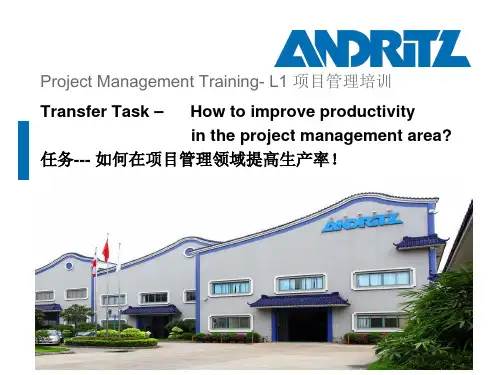

Engineering project management is a critical discipline that encompasses the planning, execution, and completion of engineering projects. It involves a complex interplay of technical, financial, and organizational elements to ensure that projects are delivered on time, within budget, and to the satisfaction of stakeholders. This article aims to provide a comprehensive overview of engineering project management, highlighting key principles and practices.Key Principles of Engineering Project Management1. Project Planning: The foundation of successful project managementlies in thorough planning. This involves defining project objectives, scope, and deliverables, as well as identifying the necessary resources, timelines, and milestones.2. Risk Management: Engineering projects are inherently risky, and effective risk management is crucial. This includes identifyingpotential risks, assessing their impact, and developing strategies to mitigate or avoid them.3. Resource Management: Efficient allocation and utilization of resources, such as personnel, materials, and equipment, are essentialfor project success. This involves workforce planning, procurement, and logistics management.4. Communication: Effective communication is vital for keeping all stakeholders informed and aligned. Regular meetings, progress reports, and clear documentation are key tools in this regard.5. Quality Control: Ensuring that project outputs meet predefinedquality standards is a fundamental aspect of engineering project management. This involves establishing quality assurance processes, conducting inspections, and implementing corrective actions as needed.6. Change Management: Projects often encounter unforeseen changes, and a robust change management process is necessary to adapt to these changes without compromising project objectives.Practical Aspects of Engineering Project Management1. Project Life Cycle: The project life cycle consists of several phases, including initiation, planning, execution, monitoring and controlling, and closing. Each phase has specific activities and deliverables that must be managed effectively.2. Tools and Techniques: Various tools and techniques are employed in engineering project management, such as project management software, Gantt charts, and critical path method (CPM) for scheduling and resource allocation.3. Stakeholder Management: Identifying and managing stakeholders' expectations and concerns is essential for maintaining their support and minimizing conflicts.4. Cost Management: Monitoring project costs and ensuring that they remain within budget is a critical task. This involves cost estimation, budgeting, and variance analysis.5. Performance Measurement: Regular performance measurement allowsproject managers to track progress, identify deviations from the plan, and take corrective actions as necessary.ConclusionEngineering project management is a dynamic and challenging field that requires a comprehensive understanding of technical, financial, and organizational aspects. By adhering to key principles and employing practical tools and techniques, project managers can ensure the successful delivery of engineering projects, contributing to the advancement of the industry and the satisfaction of clients and stakeholders.工程项目管理概述工程项目管理是一个涉及规划、执行和完成工程项目的关键学科。
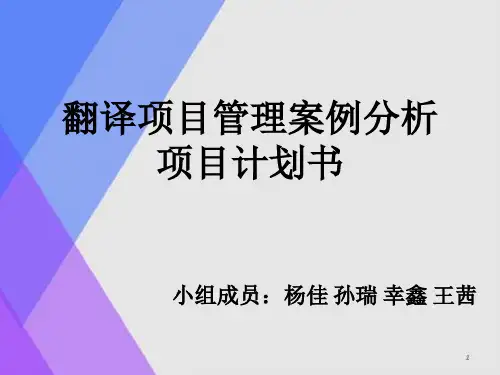
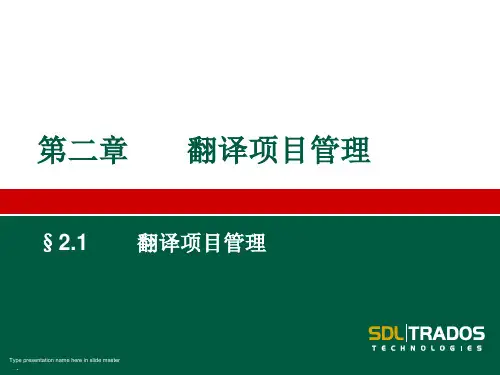

项目管理书籍英文版项目管理是现代管理中的重要领域,对于组织的成功实施和交付项目具有关键作用。
在项目管理领域,有许多经典的书籍被广泛引用和推崇。
本文将介绍几本经典的项目管理书籍的英文版,并分析它们在项目管理实践中的价值和应用。
一、《A Guide to the Project Management Body of Knowledge (PMBOK Guide)》作为国际上最重要的项目管理标准,PMBOK Guide是由美国项目管理协会(PMI)编写和发布的。
该书提供了一套广泛接受并实践于全球范围内的标准、方法和最佳实践。
PMBOK Guide对于理解和应用项目管理知识体系具有重要意义,它涵盖了范围、时间、成本、质量、人力资源、沟通、风险等方面。
二、《The Mythical Man-Month: Essays on Software Engineering》弗雷德里克·布鲁克斯(Frederick P. Brooks)在这本经典著作中讨论了软件工程中常见的问题,并提供了一些解决方案。
这本书强调了“人月神话”,即增加人力资源并不能缩短软件开发时间。
布鲁克斯通过自身的经验和案例分析,向读者传达了项目管理中的重要原则和策略。
三、《The Lean Startup: How Today's Entrepreneurs Use Continuous Innovation to Create Radically Successful Businesses》埃里克·里斯(Eric Ries)的《The Lean Startup》是一本关于创业项目管理的畅销书。
该书提出了一种创业方法论,强调通过快速迭代、持续创新和客户反馈来降低风险和提高成功率。
里斯通过实际案例和实践经验,向读者展示了如何在不确定性环境中管理项目并取得成功。
四、《Crucial Conversations: Tools for Talking When Stakes Are High》凯瑟琳·帕特森(Kerry Patterson)等人合著的《Crucial Conversations》是一本关于沟通技巧的重要书籍。
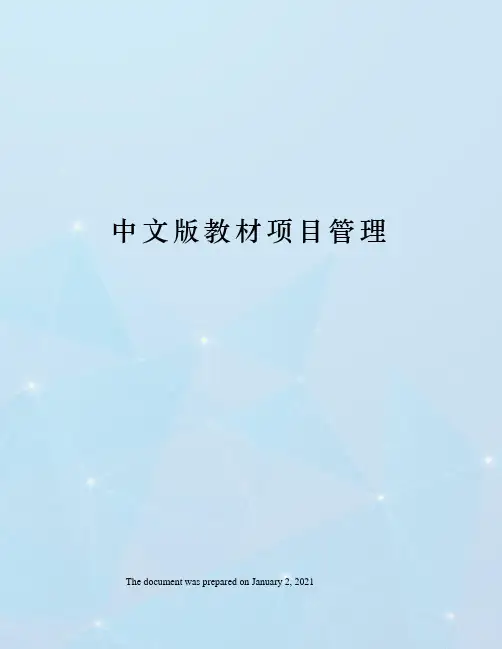
中文版教材项目管理 The document was prepared on January 2, 2021第一章绪论项目管理知识体系包含了许多内容,它是对项目管理专业知识的一个总结,正如法律、医药和会计等其它专业一样,这一知识体系也有赖于那些实践者和学者们对它加以应用和提高。
整个项目管理知识体系不仅包括那些已经被求证过的理论知识和已经被广泛加以应用的传统经验,而且还容纳了新的理论知识以及还没有被充分应用的先进经验。
本章将对几个关键术语进行定义和解释,并且给出全文的梗概,主要包括以下几个主要内容:1.1本文的目的1.2什么是项目1.3什么是项目管理1.4与其它管理方式的联系1.5相关的工作1.1本文的目的本文最根本的目的是要向大家介绍已经被普遍认可、接受的项目管理知识体系的基本内容。
"普遍认可"意味着在此所介绍的理论和实践经验在大多数时候对于大多数项目来讲都是适用的,这意味着大家对于这些理认和实践的价值用途已达成了广泛的一致。
但是,"普遍认可"并不是说这些理论和实践经验可以或者应该适用于所有的项目。
什么是对项目适用的,这应该由项目管理工作组做出决定。
作者也希望为大家探讨项目管理提供一本专业(术语)的通字典,项目管理是一个相对年轻的专业,因此在各种项目的实际运作中有大量相同类似的工作,但所使用的术语却很少相同。
本文为任何对项目管理感兴趣的人提供了一个基本的参考,主要适用于:(当然也不局限于此)·项目经理和项目组的其他人员·项目的客户和其他项目涉外人员·项目经理的主管·有下属参与项目工作的部门经理·进行项目管理和相关课程教学工作的教育工作者·项目管理及相关领域的顾问和专家·对项目管理人员进行培训的培训师由于本文在内容上还不够深刻和广泛,因此仅为大家提供了一个基本的参考。
附录E所讨论的是对项目管理应用的扩展,附录F 给出了有关项目管理上的进一步的信息采源。




IntroductionEngineering project management is a critical discipline that involves the planning, execution, and control of projects to achieve specific objectives within defined constraints. This textbook aims to provide a comprehensive overview of the principles, practices, and tools used in engineering project management. It is designed to serve as a valuable resource for students, professionals, and anyone interested in understanding and mastering the art of managing engineering projects effectively.Chapter 1: Introduction to Engineering Project ManagementThis chapter sets the stage for the study of engineering project management. It defines what a project is, the importance of project management in engineering, and the key roles and responsibilities of project managers. It also discusses the project life cycle and the various stages involved in managing a project from conception to completion.Chapter 2: Project PlanningProject planning is a fundamental aspect of engineering project management. This chapter delves into the process of creating a comprehensive project plan. It covers the following topics:- Scope Definition: Establishing the project's boundaries and deliverables.- Schedule Development: Creating a timeline for project activities.- Resource Allocation: Identifying and allocating resources needed for project execution.- Budgeting: Estimating costs and preparing a budget plan.- Risk Management: Identifying potential risks and developing mitigation strategies.Chapter 3: Project SchedulingEffective project scheduling is crucial for ensuring that project activities are completed on time. This chapter explores various scheduling techniques and tools, including:- Critical Path Method (CPM): Identifying the sequence of activitiesthat determine the project's duration.- Program Evaluation and Review Technique (PERT): Estimating activity durations and project completion times.- Gantt Charts: Visualizing project schedules and progress.- Project Management Software: Utilizing tools like Microsoft Project to manage schedules.Chapter 4: Project ExecutionProject execution is where the plan is put into action. This chapter covers the following aspects:- Team Management: Leading and motivating project team members.- Communication: Ensuring effective communication among stakeholders.- Procurement: Managing the acquisition of goods and services.- Quality Control: Ensuring that project outputs meet specified standards.- Change Management: Adapting to changes in project scope, schedule, or resources.Chapter 5: Project ControlProject control involves monitoring and adjusting the project's progress to ensure it stays on track. This chapter discusses:- Performance Measurement: Assessing project progress against the plan.- Variation Management: Handling changes in scope, schedule, or budget.- Conflict Resolution: Addressing conflicts that arise during project execution.- Project Closure: Documenting lessons learned and transitioning project deliverables to the client.Chapter 6: Project Risk ManagementRisk management is essential for identifying and mitigating potential threats to project success. This chapter covers:- Risk Identification: Identifying potential risks to the project.- Risk Analysis: Assessing the likelihood and impact of identified risks.- Risk Response Planning: Developing strategies to manage identified risks.- Risk Monitoring and Controlling: Continuously monitoring risks and adjusting responses as needed.Chapter 7: Project Quality ManagementEnsuring high-quality project outputs is a critical aspect of engineering project management. This chapter discusses:- Quality Planning: Defining quality standards and objectives.- Quality Assurance: Implementing processes to ensure quality is maintained.- Quality Control: Inspecting project outputs to ensure they meetquality standards.- Continuous Improvement: Identifying opportunities for improvingproject quality.Chapter 8: Project CommunicationEffective communication is key to the success of any project. This chapter covers:- Communication Models: Understanding different communication models and their application in project management.- Communication Plans: Developing plans to ensure effective communication among stakeholders.- Communication Tools: Utilizing tools like emails, meetings, andproject management software to facilitate communication.Chapter 9: Project Procurement ManagementProcurement management involves acquiring the necessary goods and services for project execution. This chapter covers:- Procurement Planning: Identifying procurement requirements and developing procurement strategies.- Supplier Selection: Selecting appropriate suppliers and vendors.- Contract Management: Managing contracts and ensuring compliance with terms and conditions.Chapter 10: Case Studies and Practical ApplicationsThis chapter includes real-world case studies and practical applications of engineering project management principles. It provides insights into how project management is applied in different industries and project types.ConclusionEngineering project management is a complex but essential discipline. This textbook provides a comprehensive framework for understanding and applying project management principles in engineering projects. By mastering the concepts and practices outlined in this textbook, readers will be well-equipped to manage projects effectively and achieve successful outcomes.AppendicesThe appendices include additional resources, such as templates, checklists, and guidelines for project management tasks.ReferencesThe references section provides a list of recommended reading materials for further exploration of engineering project management.。
《翻译项目管理实务》目录王华伟王华树编著总序林戊荪xiii 序言王继辉xiv 序崔启亮xvi 致谢xx 第一章翻译项目管理基础1第一节项目管理基础1第二节翻译项目管理的理论框架5第三节翻译项目管理的实务基础8本章小结13思考题14第二章翻译项目启动阶段管理15第一节项目分析管理15第二节项目评估管理21第三节项目获取管理26本章小结28思考题29第三章翻译项目计划阶段管理30第一节项目信息管理30第二节项目基准管理38第三节项目启动会议管理40本章小结42思考题43第四章翻译项目实施阶段管理44第一节项目执行管理44第二节项目跟踪管理48第三节项目提交管理53本章小结55思考题56第五章翻译项目收尾阶段管理57第一节项目审核管理57第二节客户满意度管理60第三节项目总结管理65本章小结74思考题75第六章翻译项目的沟通管理76第一节项目沟通管理概述76第二节电子邮件沟通管理79第三节会议及电话会议沟通86第四节客户投诉管理88本章小结92思考题92第七章翻译项目的质量管理93第一节翻译质量管理概述93第二节翻译质量流程管理95第三节翻译质量实践管理102第四节翻译质量管理体系113本章小结116思考题117第八章语言资产管理118第一节语言资产概述118第二节术语管理121第三节翻译记忆管理125第四节语言资产管理系统128本章小结130思考题131第九章翻译项目的财务规程132第一节启动阶段的财务规程132第二节计划阶段的财务规程138第三节实施阶段的财务规程142第四节收尾阶段的财务规程144本章小结146思考题146第十章开始管理第一个翻译项目147第一节项目规划147第二节召开项目启动会议158第三节完善项目生产工具包163本章小结170思考题171第十一章基于MCAT分解体系编制WBS172第一节WBS概述172第二节MCAT分解体系结构175第三节WBS编制实例181本章小结186思考题186第十二章翻译生产中的工具运用187第一节翻译前处理189第二节翻译生产196第三节翻译后处理211本章小结216思考题217第十三章翻译项目管理系统概述218第一节翻译管理系统基础218第二节翻译管理系统主要功能220第三节典型的翻译管理系统224第四节翻译管理系统的选择与应用256本章小结259思考题259第十四章本地化项目管理实践260第一节项目计划:最显功力的是全局视野263第二节项目发包:多走一英里265第三节项目沟通:简明、扼要、规范268第四节项目跟踪:变是唯一的不变270第五节项目提交:巨细皆无遗271跋273参考文献275附录I小中型语言服务提供商组织架构277附录II大型语言服务提供商组织架构278附录III一般本地化翻译项目流程图279附录IV莱博智公司本地化项目流程图280附录V常见的翻译管理系统281。
翻译项目管理计划书
目录:
一、项目管理计划书的重要性
二、编写项目管理计划书的指导原则
三、项目管理计划书的基本结构
四、项目管理计划书的执行和监控
五、项目管理计划书的问题解决与调整
六、项目管理计划书的评估和总结
七、项目管理计划书的持续改进
项目管理计划书是项目管理的核心文档,它包含了项目管理的
所有重要信息和计划,并指导着整个项目的实施和控制。
一个完善的
项目管理计划书可以帮助团队成员清晰地了解项目目标、范围、进度、成本、质量、风险等方面的情况,从而提高项目的管理效率和成功率。
编写项目管理计划书时,需要遵循以下指导原则:确保与项目目
标和需求保持一致;明确项目管理的方法和流程;合理分配资源和责任;设定可实现的目标和里程碑;定期审查和更新计划内容。
项目管理计划书通常包括以下基本结构:项目简介、项目目标和
范围、项目时间计划、项目成本预算、项目质量要求、项目风险分析、项目沟通计划、项目团队组织、项目执行和监控计划等内容。
在实施和监控阶段,项目管理计划书需要根据实际情况进行调整
和更新,及时解决项目中出现的问题和风险,确保项目进展顺利进行。
评估和总结是项目管理计划书的重要环节,通过总结项目执行过
程中的经验教训和成功因素,为未来的项目提供指导和借鉴。
持续改进是项目管理计划书的必然要求,需要根据不断变化的需
求和环境,不断完善和调整项目管理计划书,以确保项目的成功实施
和管理。